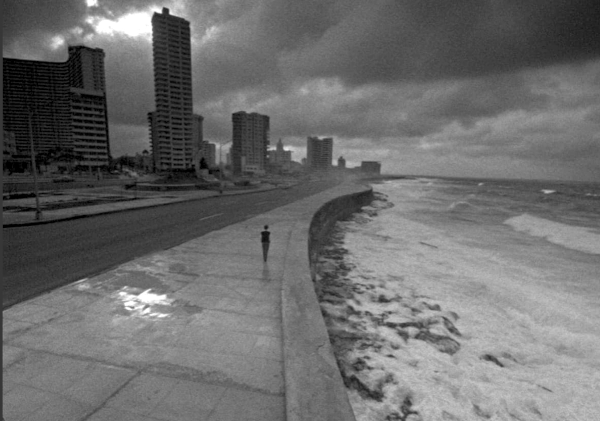I Am Cuba – 4K
Milestone films and the Criterion Collection team together for this 1964 epic, a a joint Cuban-Soviet super-travelogue celebration of the revolutionary spirit. Four vignettes from the pre-Castro years spell out the glory of anti-imperialism, using fancy visuals and gravity-defying camerawork. The cultural experiment was judged a failure and shelved for decades, until it was rediscovered in the 1990s and given a major film festival revival. The impressive B&W cinematography gets the full 4K ULTRA HD treatment.

I Am Cuba
4K Ultra HD + Blu-ray
The Criterion Collection 1214
1964 / B&W / 1:33 flat / 141 min. / available through The Criterion Collection / Street Date April 23, 2024 / 39.96
Starring: José Gallardo, Raúl Garcia, Luz María Collazo, Mario González Broche, Raquel Revuelta.
Cinematography: Sergei Urusevsky
Production Designer: Yevgeni Svidetelev
Film Editor: Nina Glagoleva
Costume Design: René Portocarrero
Original Music: Carlos Fariñas
Screenplay by Enrique Pineda Barnet, Yevgeni Yevtushenko
Produced by ICAIC, Mosfilm
Directed by Mikhail Kalatazov
 Twenty years ago, one of the disc companies that truly earned our respect was Milestone Films, which persisted in championing films and filmmakers not likely to be embraced by studio-based home video outlet. One of their most impressive disc sets was a deluxe ‘ultimate edition’ packaged in a carton that looked like a Cuban cigar box. We’ve kept it on display all this time, and it still gets compliments. (image below, in color)
Twenty years ago, one of the disc companies that truly earned our respect was Milestone Films, which persisted in championing films and filmmakers not likely to be embraced by studio-based home video outlet. One of their most impressive disc sets was a deluxe ‘ultimate edition’ packaged in a carton that looked like a Cuban cigar box. We’ve kept it on display all this time, and it still gets compliments. (image below, in color)
This Criterion release of the legendary I Am Cuba follows up on Milestone’s pioneering effort — they were the ones to lift the film from historical obscurity in the 1990s, making it an audience-wowing spectacle. Mikhail Kalatazov’s ‘lost’ revolutionary epic is still a Milestone film, but now remastered in 4K Ultra HD and reissued as part of the Criterion Collection.
Originally titled in Spanish as “Soy Cuba”, the film is an ode to the spirit of Fidel Castro’s Revolution, told in four poetic movements that extol Cuban resistance to the corrupt, murderous regime of the dictator Fulgencio Batista. The film’s artistic aim is to revive the kinetic ‘revolutionary’ cinema of the silent days, and the real star of the show is Sergei Urusevsky’s acrobatic camera. When not indulging in expressive tilted angles or soulful silhouettes, Urusevsky’s camera ducks and weaves to follow Kalatazov’s frenzied direction. One of the first shots performs feats of near magic as it glides up and down the side of a building and into a swimming pool.
A champion of the ostentatious, complex moving scene master shot.
Fans still talk about the most dazzling show-off shot, even in our era of all-debasing CGI. After following a funeral procession, the camera climbs several floors above the crowd, cruises through one building, floats over to a second building, and then glides off a balcony to hover over the crowds honoring a revolutionary martyr.
Seven years before, during Khruschev’s cultural thaw, director Mikhail Kalatazov had made the U.S.S.R.’s most celebrated international export hit, The Cranes are Flying. Dynamic subjective camera work greatly enhanced that tragic romance; Soy Cuba constructs an entire epic from similar visual gynmastics. Several elaborate handheld scenes last more than a minute without a cut, as the ultra wide-angle lens tracks action like a snake. Urusevsky uses infrared film stock to increase contrast, which turns the ocean black and makes foliage glow an unnatural white. Some accounts say that the film may have been the first to use a video assist to allow Kalatazov to instantly review his takes. Didn’t Jerry Lewis once make that claim?
Definitely not a standard commercial enterprise, Soy Cuba was a political gambit designed to strengthen the ties between Castro’s Cuba and the Soviets, with a grand statement of solidarity with the infant revolution. But the style and tone views everything through a Russian filter. Despite the involvement of top Cuban writers the film is ultimately more concerned with political image-making than the reality of Cuban life.
The aim seems to be to follow in the footsteps of the Soviet filmmaker Sergei Eisenstein, whose work was honored even as the Stalin regime barely tolerated him. Essayist Juan Antonio García Borrero tells us that footage of Eisenstein’s unfinished ¿Que viva México! was used as an example of how Soy Cuba should look. The movie abounds in ‘peasant portraits’ that glorify the proletariat, and painterly images that remind us of the work of cinematographer Gabriel Figueroa.
The non-pro actors provide the expressive ‘earthy’ faces but the ideologically minded script and the fancy camerawork do the heavy lifting. The attempt to communicate with Battleship Potemkin-like imagery replaces the master’s montage aesthetics with newer, more audacious camera techniques. Kalatazov uses the steps of the Havana University to stage a dramatic, if simplistic student/police confrontation suggestive of Potemkin’s Odessa Steps sequence. Back in 1933, the same steps had been a focus of rebellion against the dictator Gerardo Machado; John Huston recreated an incident on them when Machado’s police fired on students without warning, for his political thriller We Were Strangers (1949).
A soothing female narrator (Raquel Revuelta) provides a voice for the country itself, in transitions between the four main episodes. All are set before the revolution; all rely on poetic moving camera set pieces, like the funeral with the floating camera viewpoint. In another story a shot on a canoe glides past marshland huts where children play and mothers work. A bathing suit contest takes place on a high balcony, and the camera descends to observe the rich cavorting by a pool, itself several stories in the air. The cabaret song “Loco Amor” introduces a nightclub where fancy prostitutes are offered to rich American tourists. ‘Good’ Cuban girl Mariía (Luz María Collazo) hides this sordid activity from her naïve boyfriend, and reports for duty at the nightclub. She tries to forget her shame in a wild dance.
Other episodes are little more than revolutionary anecdotes. Told that the land he farms has been sold to the United Fruit Company, old Pedro (José Gallardo) realizes he’ll no longer be able to make a living. He sends his kids to town to drink Coca-Cola and decides to torch everything that might profit the new owners.
University student Enrique (Raúl Garcia) is set with a high-powered rifle, but cannot make himself assassinate Havana’s corrupt police chief. He then throws himself into harm’s way by leading a student demonstration and confronting armed police on the University steps.
A peasant in the hills thinks he can avoid the fighting, but when the government bombs his home and kills one of his children, he takes up a gun and joins la revolucíon.
The first episode takes a page from Italian Neorealism. María’s American client follows her to her home in a shanty town, only to be panicked by the awful poverty and hunger he finds there. It’s a bald lift from Roberto Rossellini’s Paisan (1946), the haunting scene when a black U.S. soldier chases after an Italian kid, and discovers an entire community living in horrendous squalor.
The visuals are breathtaking, but I Am Cuba still plays as unsubtle propaganda. The scenery is Cuban but the ideology is Russian; the Cuban characters are little more than symbols. Traditional guitar music is by definition beautiful and American Rock ‘n’ Roll is depraved. The evil Yankees (played by obvious Russians) think they can buy everything especially ‘exotic’ Habaneras. Even a relatively thoughtful intellectual takes María’s crucifix as a souvenir. Havana’s revolutionary youth are impassioned martyrs, and photogenic rural peasants are noble Children of God. The farmer’s family must suffer before he embraces the ecstasy of armed revolution, a sequence that Kalatazov illustrates with fluid imagery Eisenstein only dreamed of. In one scene, a fallen comrade appears to rise from the dead to participate in the glory of victory.
The expensive, ambitious production was released in 1964, when the aftermath of the Cuban Missile Crisis was having a cooling effect on Moscow-Havana relations. Kalatazov’s ‘technique over content’ philosophy may have clashed with an ideological preference for oldfashioned socialist realism, and proud Cubans likely didn’t appreciate seeing their national destiny interpreted in terms of the Russian revolution. As often happened with ‘disappointing’ Soviet movies, Soy Cuba was soon suppressed and forgotten.
Thirty years later, Milestone Films brought I Am Cuba back from total obscurity. Audiences found plenty of reasons to admire Kalatazov’s epic. As a visuals of Havana are in themselves a priceless historical record. When the student revolutionaries argue on a street corner, the background is Havana’s Cinerama Theater, with the yanqui movie Esto es Cinerama! announced on its marquee.
When film students talked about I Am Cuba, the buzz usually centered on its spectacular no-cuts extended moving master shots — the kind that Martin Scorsese was getting attention for, in pictures like Goodfellas. With this show Kalatazov cemented his kinship with Orson Welles and Max Ophuls as a master of the choreographed hand-held camera. His twisting, gravity-defying camerawork tends to bowl over first-time viewers, leaving memories of a few expressive faces and a LOT of swirling visuals. A second pass allows us to appreciate the economy of Kalatazov’s storytelling. His characters are animated by sheer visual power. Accept them as iconic players in the collective revolution, and the film works.
The Criterion Collection’s 4K Ultra HD + Blu-ray of I Am Cuba is a 4K digital restoration made from a fine-grain 35mm printing element for the film. The presentation is spread across two discs. The first 4K UHD disc has the feature alone, and a Blu-ray carries a second feature encoding and all of the extras.
Although a great many Soviet films in the 1960s were shot anamorphic and even on 65mm, I Am Cuba reverted to Eisenstein- era flat B&W. The cinematography varies between docu-drama realism and the kind of stylization we associate with rarified art films. Nobody argues that Soy Cuba doesn’t please the eye.

← The 2007 DVD and the 2024 4K UHD.
The extras begin with The Siberian Mammoth, an intriguing 2004 documentary retained from the old DVD special edition. Key interviews with Russians and Cubans delivers an interesting dialogue about cinema, politics and national identity. An older appreciation by Martin Scorsese is present; he and Francis Ford Coppola were instrumental in making the U.S. premiere happen back in the early 1990s. Scorsese says that his entire career might have been different had he seen I Am Cuba when it was new. Bradford Young provides a new visual essay on the picture, while Juan Antonio garcía Borrero’s insert folder essay probes the testy Russian-Cuban relationship during production.
Some of the commentary acknowledges the tepid reception given Soy Cuba by Havana’s film critics. The major complaint was that it was too Russian and insufficiently Cuban, that the film’s style and content both felt imposed from without. The Russians had funded the founding of Instituto Cubano del Arte e Industrias Cinematográficos, the national Cuban film company. But it was developing a raw cinematic style very different from Kalatazov’s classic forms and technical tricks — as seen in the masterpieces Lucía (Humberto Solás) and Memorias de subdesarollo (Tomás Gutiérrez Alea). *
The presentation has two soundtracks — a Cuban track in Spanish with a little English, and a Russian dubbed version for folks back in the U.S.S.R..
It’s an impressive disc — and will take its place next to the old ‘cigar box’ DVD special edition.
Reviewed by Glenn Erickson

I Am Cuba
4K Ultra HD + Blu-ray rates:
Movie: Excellent
Video: Excellent
Sound: Excellent (Spanish Track + Alternate Russian dub
Supplements:
2004 documentary The Siberian Mammoth
Interview from 2003 with Martin Scorsese
New appreciation of the film by Bradford Young
Trailer
Foldout insert with an essay by Juan Antonio García Borrero.
Deaf and Hearing-impaired Friendly? YES; Subtitles: English (feature only)
Packaging: One Blu-ray in Keep case
Reviewed: April 27, 2024
(7119soy)

Visit CineSavant’s Main Column Page
Glenn Erickson answers most reader mail: cinesavant@gmail.com
Text © Copyright 2024 Glenn Erickson











An impressive movie, if corny.
Is it me or do your posts keep disapearing?
Must be a bug.
The Soviet Union…I thought that disbanded 30 odd years ago?
Doesn’t negate the film’s merits or lack of them.
Just like the people who railroaded the Rosenbergs through the court (don’t forget that the Rosenbergs later got proven innocent).